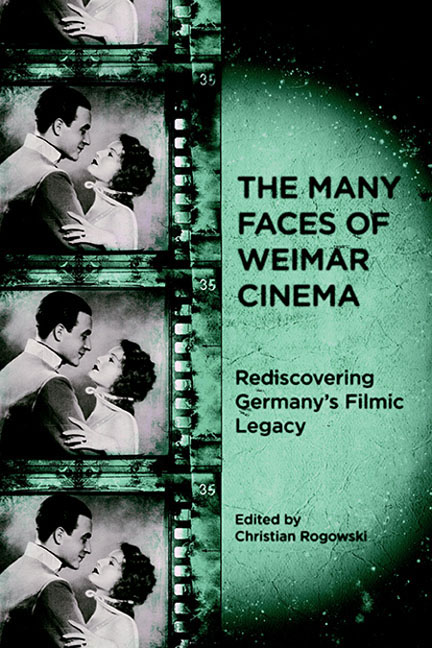Book contents
- Frontmatter
- Contents
- List of Illustrations
- Preface
- Introduction: Images and Imaginaries
- 1 Richard Oswald and the Social Hygiene Film: Promoting Public Health or Promiscuity?
- 2 Unsettling Nerves: Investigating War Trauma in Robert Reinert's Nerven (1919)
- 3 Humanity Unleashed: Anti-Bolshevism as Popular Culture in Early Weimar Cinema
- 4 Desire versus Despotism: The Politics of Sumurun (1920), Ernst Lubitsch's “Oriental” Fantasy
- 5 Romeo with Sidelocks: Jewish-Gentile Romance in E. A. Dupont's Das alte Gesetz (1923) and Other Early Weimar Assimilation Films
- 6 “These Hands Are Not My Hands”: War Trauma and Masculinity in Crisis in Robert Wiene's Orlacs Hände (1924)
- 7 The Star System in Weimar Cinema
- 8 Schaulust: Sexuality and Trauma in Conrad Veidt's Masculine Masquerades
- 9 The Musical Promise of Abstract Film
- 10 The International Project of National(ist) Film: Franz Osten in India
- 11 The Body in Time: Wilhelm Prager's Wege zu Kraft und Schönheit (1925)
- 12 Henrik Galeen's Alraune (1927): The Vamp and The Root of Horror
- 13 The Dialectic of (Sexual) Enlightenment: Wilhelm Dieterle's Geschlecht in Fesseln (1928)
- 14 Babel's Business — On Ufa's Multiple Language Film Versions, 1929–1933
- 15 “A New Era of Peace and Understanding”: The Integration of Sound Film into German Popular Cinema, 1929–1932
- 16 Landscapes of Death: Space and the Mobilization Genre in G. W. Pabst's Westfront 1918 (1930)
- 17 Undermining Babel: Victor Trivas's Niemandsland (1931)
- 18 Unmasking Brigitte Helm and Marlene Dietrich: The Vamp in German Romantic Comedies (1930–33)
- Filmography
- Notes on the Contributors
- Index
Introduction: Images and Imaginaries
Published online by Cambridge University Press: 29 April 2017
- Frontmatter
- Contents
- List of Illustrations
- Preface
- Introduction: Images and Imaginaries
- 1 Richard Oswald and the Social Hygiene Film: Promoting Public Health or Promiscuity?
- 2 Unsettling Nerves: Investigating War Trauma in Robert Reinert's Nerven (1919)
- 3 Humanity Unleashed: Anti-Bolshevism as Popular Culture in Early Weimar Cinema
- 4 Desire versus Despotism: The Politics of Sumurun (1920), Ernst Lubitsch's “Oriental” Fantasy
- 5 Romeo with Sidelocks: Jewish-Gentile Romance in E. A. Dupont's Das alte Gesetz (1923) and Other Early Weimar Assimilation Films
- 6 “These Hands Are Not My Hands”: War Trauma and Masculinity in Crisis in Robert Wiene's Orlacs Hände (1924)
- 7 The Star System in Weimar Cinema
- 8 Schaulust: Sexuality and Trauma in Conrad Veidt's Masculine Masquerades
- 9 The Musical Promise of Abstract Film
- 10 The International Project of National(ist) Film: Franz Osten in India
- 11 The Body in Time: Wilhelm Prager's Wege zu Kraft und Schönheit (1925)
- 12 Henrik Galeen's Alraune (1927): The Vamp and The Root of Horror
- 13 The Dialectic of (Sexual) Enlightenment: Wilhelm Dieterle's Geschlecht in Fesseln (1928)
- 14 Babel's Business — On Ufa's Multiple Language Film Versions, 1929–1933
- 15 “A New Era of Peace and Understanding”: The Integration of Sound Film into German Popular Cinema, 1929–1932
- 16 Landscapes of Death: Space and the Mobilization Genre in G. W. Pabst's Westfront 1918 (1930)
- 17 Undermining Babel: Victor Trivas's Niemandsland (1931)
- 18 Unmasking Brigitte Helm and Marlene Dietrich: The Vamp in German Romantic Comedies (1930–33)
- Filmography
- Notes on the Contributors
- Index
Summary
What images does the notion “Weimar Cinema” conjure up? The twisted physiognomy of Conradt Veidt's somnabulist Cesare in Robert Wiene's The Cabinet of Dr. Caligari (1920), as he drags off damsel-in-distress Lil Dagover over the slanted nocturnal rooftops? The spooky shadow of Max Schreck's spidery vampire in F. W. Murnau's Nosferatu (1921), as he approaches his next innocent victim? The bulky presence of Emil Jannings as Mephisto in Murnau's Faust (1925), casting a furtively sinister look over his shoulders? The faceless hordes of despondent workers descending into the grimy futuristic underworld of Fritz Lang's Metropolis (1927)? Or Marlene Dietrich's shapely legs in Josef von Sternberg's The Blue Angel (1930) — as Lola Lola, the vamp, crooning seductively as she sits astride a barrel on the makeshift stage of a seedy nightclub?
The prevailing view of Weimar Cinema as sinister auteurist cinema is to a large extent the product of two accounts that came out in the aftermath of the Second World War: Siegfried Kracauer's provocatively titled From Caligari to Hitler (1947) established the view that the films produced during the Weimar period should be read as manifestations of a kind of collective unconscious, displaying a uniquely German preoccupation with authority and a desire for submission that foreshadows the willingness of Germans to submit to real-life dictator Adolf Hitler. Lotte H. Eisner's The Haunted Screen (first published in France in 1952 as L'écran démoniaque — literally, the “demonic screen”) offers a complementing notion of a German predilection to brooding introspection by anchoring the artistic imagination of Weimar-period filmmakers in the tradition of early nineteenth- century German Romanticism, which found its way into film under the influence of legendary theater impresario Max Reinhardt.
These accounts, written by exiled German Jewish intellectuals in the aftermath of National Socialism, war, and the Holocaust, cast the Weimar Cinema as precursor to, or prophet of, the Third Reich and as heir to specifically German cultural traditions, suggesting a direct correlation, perhaps even a causal nexus, between cultural production and historical realities. Such theories appear to be predicated on a monolithic notion of national or cultural identity that supposedly finds its direct expression in films.
- Type
- Chapter
- Information
- The Many Faces of Weimar CinemaRediscovering Germany's Filmic Legacy, pp. 1 - 12Publisher: Boydell & BrewerPrint publication year: 2010



